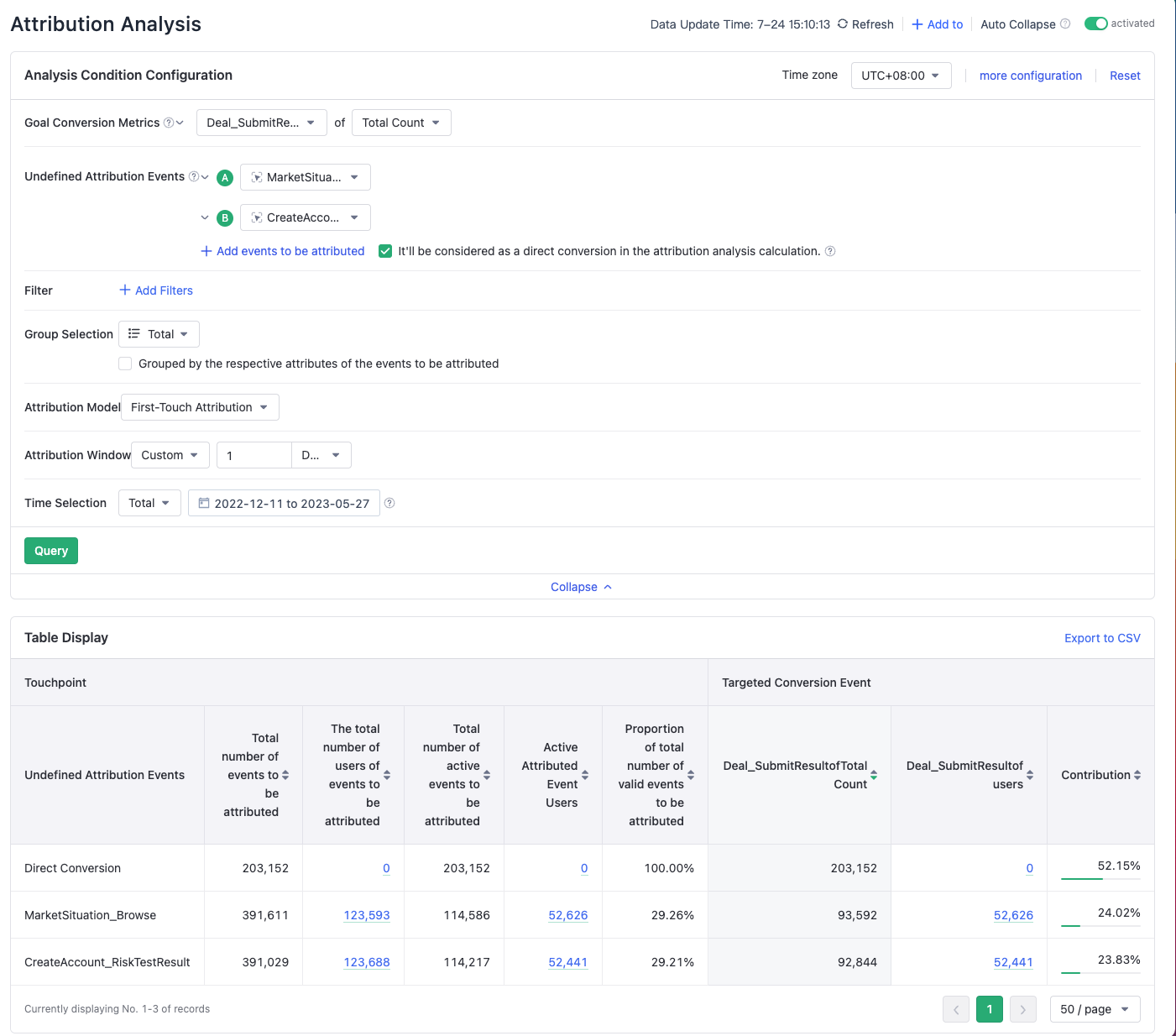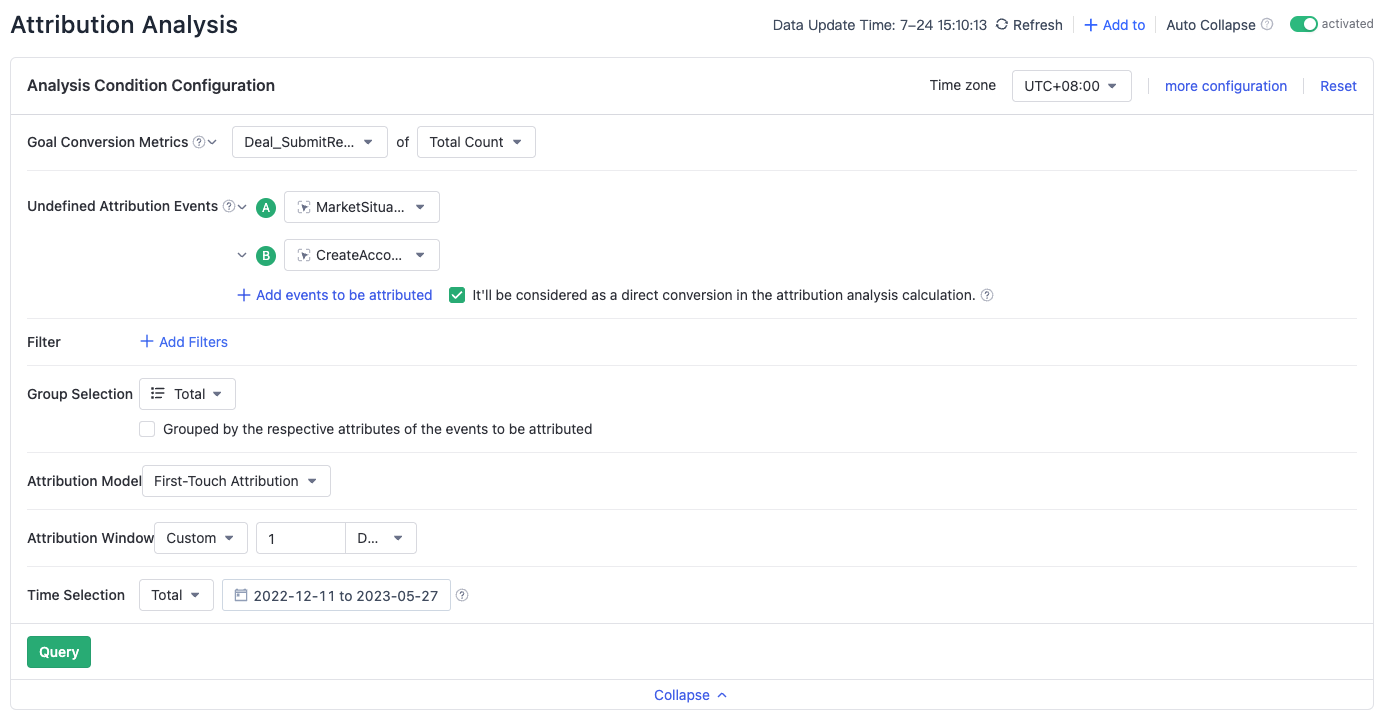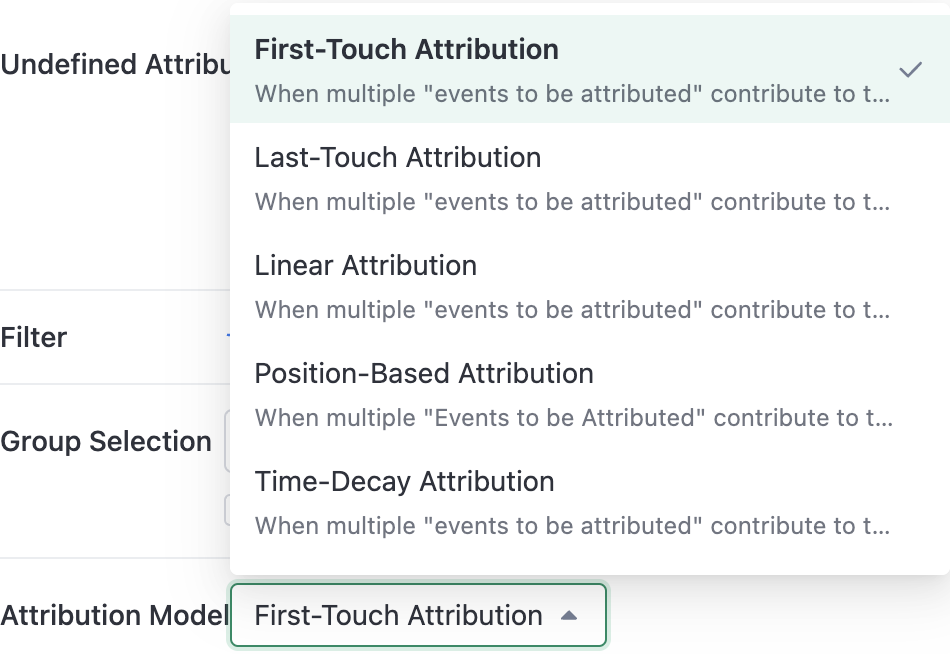Attribution analysis
|
Collect
1. Function overview
When the business needs to analyze the transformation contribution of a certain advertising space or promotion space to the target metric, the attribution analysis model can be used for analysis. In the attribution analysis model, the click of the advertising position and the click of the promotion position are called "metric, undefined Attribution Events", and the order amount of the order to pay for the order is called "goal conversion metric".
2. Instructions
The attribution analysis module consists of two parts, namely:
- Attribution analysis configuration area
- Attribution result table display area

2.1. Attribution analysis configuration area

Target conversion index:
- Select the attribution objective to be analyzed, generally revenue-related indicators, such as: number of orders, payment amount...
- Supports the selection of the total number of times for all meta-events and virtual events, as well as the sum of numeric type attributes contained in the events
Add forward-associated events for target transformation events:


- Forward-associated events
- The forward event of the target transformation event is selected to improve the calculation accuracy of the attribution model. Generally select events that are strongly associated with the target event, similar to product exposure, such as: viewing product details, adding to the shopping cart...
- Association attribute: An attribute that associates a target transformation event with a forward-associated event
- Forward-associated events
Undefined Attribution Events
- Select the event to be attributed, generally related to advertising exposure, recommendation exposure and other operational events, such as: click on the AD space, click on the recommendation...
- You can select all meta events and virtual events
Multiple events to be attributed can be grouped according to the common attributes of the events to be attributed or the attributes of the events to be attributed
attributional model

- First-Touch Model: When multiple "events to be attributed" contribute to the same "goal conversion event", the first "events to be attributed" is considered to be 100% credited.
- Last-Touch Attribution: When multiple "events to be attributed" contribute to the same "goal conversion event", the last "events to be attributed" is considered to be 100% responsible.
- Linear Attribution: When multiple "events to be attributed" contribute to the same "goal conversion event", the credit for each "events to be attributed" is evenly distributed.
- Position-Based Attribution: When multiple "events to be attributed" contribute to the same "goal conversion event", the first and last "events to be attributed" each account for 40% of the credit, with the remaining "events to be attributed" evenly splitting the remaining 20% of the credit.
- Time-Decay Attribution: When multiple "events to be attributed" contribute to the same "Target conversion event", the closer the "To be attributed event" is to the "Target conversion event", the greater its contribution.
- Attribution Window
- In the "Attribution Window", you can select "Today" or customized time.
- The calculation logic for "Today" is that forward-related events and "events to be attributed" are traced back to the same day as the target event.
- For a customized time of 1 day, it refers to the forwarding related events and "events to be attributed" occurring within 24 hours of the target event.
- In the "Attribution Window", you can select "Today" or customized time.
- Time Granularity
- It supports viewing the attributed results of the selected "events to be attributed" and the target conversion metrics, and also supports viewing detailed attribution data by "day" or "hour".
2.2. Attribution Result Table Display Area

- The table displays the contribution frequency and credit of the "Target Conversion Event" under each touchpoint.
- Definitions of indicators:
- Total number of "events to be attributed": the total number of occurrences of "events to be attributed" within the selected time range plus the attribution window period.
- Total number of users of "events to be attributed": the number of unique users who have performed "events to be attributed" within the selected time range plus the attribution window period.
- Total number of valid "events to be attributed": the total number of occurrences of "events to be attributed" that have contributed to the target event within the selected attribution model and the attribution window period. If one "events to be attributed" contributes to multiple target metrics, it will only be counted once.
- Total number of valid users of "events to be attributed": the number of unique users who have performed "events to be attributed" that have contributed to the target event within the selected attribution model and the attribution window period.
- The proportion of total number of valid "events to be attributed": Total number of valid "events to be attributed"/ Total number of "events to be attributed"
- Total times of "Target Conversion Event": The number of times that "Target Conversion Event" occurred within the attribution window period after being allocated according to the selected attribution model.
- For example, if the "Target Conversion Event" is a payment order, and the contribution results of the corresponding ad space after Position Attribution are (ad space A (40%), ad space B (20%), ad space A (40%)), then the total times of A's "Target Conversion Event" = 1 * (40% + 40%) = 0.8, B's total times of "Target Conversion Event" = 1 * 20% = 0.2
- Total users of "Target Conversion Event": the number of unique users who have performed "Target Conversion Event" within the window period after being allocated according to the selected attribution model.
- Support viewing the number of target conversion users only for the first and last attribution, because for other attribution models, the contribution of a waiting-to-be-attributed event is not 1, for example, 20%, which will result in the number of target conversion users being 0.2, not in line with the semantics of users.
- Conversion Contribution of Target: The total number of target conversion events under the current event to be attributed / the sum of the total number of all target conversion events.
Note: The content of this document is a technical document that provides details on how to use the Sensors product and does not include sales terms; the specific content of enterprise procurement products and technical services shall be subject to the commercial procurement contract.
 Popular Searches
Popular Searches